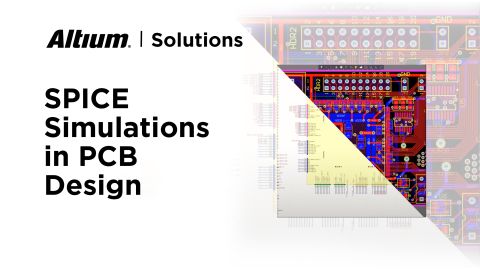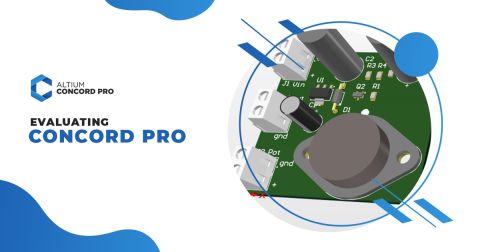Selecting and Tracking a General-Purpose Op-Amp

Altium Concord Pro™ as a standalone product and brand name has been discontinued and the capabilities are now available as part of our Altium enterprise solutions. Learn more here.
Introduction
There are few things in life as satisfying as concluding the debug of an analog/digital signal chain. When you realize that your circuitry is working as intended. That adorable microcontroller is a getting clean and intelligible signal; you can finally reward yourself with half an hour of YouTube-powered procrastination because you achieved something that day.
The success of any circuit is built mainly upon your ability to select the right components for the job. Every company in the electronic business struggles with choosing general-purpose ICs. Many engineers have their preferred jelly-bean transistors, logic gates, or SMD LEDs. I know high-efficiency reverse-mount blue LEDs bring a childish tear of joy to my eye, and I am not the only one. Building a substantial library of components that you can adopt time and time again can lower production costs and simplify the engineering effort required to launch new products into the market.
As probably the most flexible analog component in our arsenal, choosing the right Op-Amp is especially critical. The right Op-Amp can make the difference between never-ending quality and performance struggles and a smooth, decade-long production in which you barely have to lift a finger.
I’m a bit in love with the LM324DT, and I’m not afraid to admit it. I’ve been using it for a few years in a series of affordable scientific equipment to teach physics and electronic engineering in some of the top universities worldwide.
What are the most critical parameters to consider when selecting a general-purpose Op-Amp?
Number of Circuits
Huge slabs of silicon like FPGA and computer processors have pricing that is dictated mostly by the surface area of the silicon die (including its influence on the yield), the scarcity of the ever-so-dense technological processes such as 5nm, the cost of intellectual property, research, and development. Small analog and digital components don’t tend to follow the same rules. Many of the Op-Amps that we could consider as valid general-purpose choices are over 20 years old and have sold billions of pieces. All the research and development costs have long been recovered, and the fabrication processes have been running successfully for decades parallel in multiple separate economic blocks.
When buying in bulk quantities, simple, general-purpose, consistent-quality ICs tend to be almost always close to three pennies, especially when not buying directly from the factory but through a middleman. Most of the cost is due to the bare die, testing, packaging, and shipping.
There is not much variation between the price of single-circuit and multiple-circuit Op-Amps, as much of the process is the same.
Using multi-circuit Op-Amps allows saving board space, decoupling capacitors, and assembly cost. Additional Op-Amps can also be used to increase performance and reliability, for example, by adding input and output followers to delicate analog sub-circuits, making their performance independent from the impedance of sources and loads.
Whenever possible, you should coalesce multiple separate Op-Amps into a single IC. Leaving some unused Op-Amps can also help you during the development stage.
Power Supply
The most crucial power supply parameters of an Op-Amp are its supply voltage range, the power consumption, and the PSRR (Power Supply Rejection Ratio).
Op-Amp power consumption, similarly for most analog ICs, is usually measured in milliamps (or microamps) instead of milliwatts.
Your power requirements will vary depending on whether your product is battery-powered or not. We’ve been blessed with a new generation of lower-power and high-precision Op-Amps in the last decade, but the price hasn’t gone down yet to the level of ICs that have been in continuous production for over 40 years. Power consumption of a few microwatts is typical in modern CMOS designs, but the milliwatt BJT range is still the most affordable.
A PSRR over 100dB is safely into the “don’t have to worry about that” realm for a general-purpose Op-Amp.
The LM324DT has a 100dB of PSRR, 375uA of supply current (times four amplifiers that amount to 1.5mA), and is usable at 5V. The datasheet specifies single supply operation from 3V, but with basically only half the input voltage usable at 1.5V and limited output current capability, it’s hardly worth considering.
For usage at 3.3V, I would strongly recommend a Rail to Rail Input and Output (RRIO) CMOS Op-Amp, such as Microchip’s MCP6001. This Op-Amp is one of the highest-selling ICs of all time, primarily due to low-cost and ticking many boxes, but there are some trade-offs to consider. Compared to similarly priced BJT Op-Amps, the offset voltage is rather mediocre. The picoampere input current can be problematic when the PCB is not adequately designed. Implementing guard traces in all your designs can be rather annoying, and low bias currents expose your boards to variation in performance due to ambient pollution and manufacturing processes.

In recent years many PCB assemblers have switched to using fully no-clean or water-soluble flux to cut down on environmental pollution. This change makes me feel proud of our industry, but improperly cleaned water-soluble fluxes can leave hygroscopic residues. Such residues, when activated by ambient humidity, can induce an increase in leakage current. In designs where the input bias current has an order of magnitude of at least a few nanoamps, this is rarely a problem, but care must be taken when using CMOS Op-Amps with picoampere-level input currents.
Input
What I’ve always desired out of a general-purpose amplifier is a low input offset voltage, a bias current low enough for most applications but not too low as to complicate our PCB design with guard traces. These inputs can get as close as possible to the power supply rails and a good CMRR (Common Mode Rejection Ratio).
If an Op-Amp can’t get close to ground enough, we can’t use it practically as a non-inverting amplifier single-supply operation without having to resort to a virtual ground. Interfacing with ADCs, also becomes increasingly difficult, strikingly so when the ADC is embedded in a microcontroller.
Getting closer to the upper supply rail is another matter entirely.
Rail to rail Op-Amps tends to trade off performance such as input bias current and common-mode rejection ratio (CMRR) when getting closer to the upper power supply rail. Some of them adopt an integrated charge-pump circuit to create an internal voltage higher than the top rail, but the silicon capacitors in the die add cost and complexity. It took many years for the industry to reach comparable performance between standard Op-Amps and RRIO ones, years that standard Op-Amps have leveraged to become cheaper and cheaper.
In the end, getting close to the upper supply rail is useful but not necessary in most applications. Most circuits can be designed to work just as well between ground and 4V instead of ground and 5V. The numbers are not going to be as pretty and well-rounded, but there are worst tragedies in life.
Input offset voltage should be kept under 5mV (1/1000th of the 0-5V range) to be acceptable in the broadest spectrum of general-purpose applications.
A bias current of under 100nA should be good enough for most practical uses. With a 100K input resistor, that would equate to an added 10mV of offset.
The LM324ST has a bias current of 20nA, equivalent to 2mV at 100Kohm of bias, the same order of magnitude of the offset voltage of 3mV (worst case at ambient temperature).
Output
I’d like an Op-Amp to have at least 20mA of output current when powered at 5V to drive simple RC low-frequency filters and be useful for buffered outputs.
Ideally, the output would swing as close to the top rail as possible, but only CMOS RRIO (Rail to Rail Input and Output) Op-Amps allow this.
Similarly to how the input bias current and CMRR can get worst as the input common-mode voltage gets close to the top rail, the output stages of CMOS amplifiers usually do not perform as well when approaching V+.
Many analog circuits require concatenating two or more Op-Amps, so using ICs with similar performance on both inputs and output often leads to simpler designs.
My Favorite Op-Amps
Picking an Op-Amp can sometimes resemble marriage. Choose unwisely, and you can quickly grow resentful and despotic. But if you’re lucky, every passing day, you find yourself a little bit more grateful for your choice, eventually looking back, smiling about it.
No Op-Amp is right for all applications. But there is one Op-Amp I can trow in almost every product and find a place for it, and that’s the LM324DT by ST Microelectronics.
It’s also one of the few components from a major brand that is as affordable as what you can find in Shenzhen markets, going down to almost 0.03 USD (and that’s for 4 Op-Amps!).
The only severe downside of the LM324DT is the limited performance when powered from 5V or 3.3V.
Luckily there are many alternative Op-Amps for low-voltage applications with similar specs. Texas Instruments manufactures a low-voltage variant of the LM324, the LM324LV. Microchip manufactures the ever-so-popular MCP6001 and its multi-circuit variants.
When designing bards where cost is not the first factor to consider, such highly-engineered artisanal instruments as my Hall Effect Apparatus, I like to choose Analog Devices AD8605. The CMRR is not the best in the industry, but everything else is astounding.
Keeping Track of all the Op-Amps
Over the past decades, the power supply voltage of most designs has lowered considerably. First, we saw the most famous families of microcontrollers transition from five volts to 3.3V. Recently, as more and more devices adopt slim single-cell lithium batteries and lowering power consumption becomes even more important, we have witnessed the rise of 1.8V microcontrollers.
It’s not unreasonable to expect the LM324DT and other similar Op-Amps to become obsolete and fall out of favor in the coming years. If the leading US manufacturers decide to drop production because it’s unprofitable, similarly to what happened in 2018 with the MLCC crisis, unreliable knock-off could flood the market and induce wild price fluctuations.
More modern lower-voltage and lower-consumption Op-Amps will inevitably replace my beloved LM324DT when times come.
Supply-chain issues may make me a bit overly-dramatic, but as engineers, it is our job to estimate and contain the uncertainty of the future. Components as ubiquitous as general-purpose Op-Amps should be carefully tracked and wisely managed in every project.
How to track your Op-Amps with Altium Concord Pro and Altium 365
One of the features that made me fall in love with Altium Concord Pro is “Where Used.” It’s not flashy. It doesn’t cover half the user interface. It’s barely mentioned in the documentation or the marketing material, but it’s the best invention since sliced bread.
The feature displays where your components are used inside of the components and explorer panels.

To take advantage of “Where Used” you don’t need to do anything but use Concord Pro regularly, either self-hosted on running on Altium 365 cloud. The software will track component usage and automatically link your projects and managed schematic sheets together with the components in your libraries.
In this example, I will create two projects and a managed schematic sheet. One board will be a bipolar Howland Current Pump, one of my all-time favorite analog circuits, meant to operate from a 12V supply.

If you want to deepen your understanding of how this circuit works, I recommend reading AN-1515 A Comprehensive Study of the Howland Current Pump by Texas Instruments.
Instead of going through the usual process of drawing symbols, footprints, finding the datasheet, and documenting the component parameters, I can take advantage of the “Manufacturer Part Search” panel to acquire the LM324DT directly into my Concord Pro server hosted on Altium 365.

The second board is a simple single Op-Amp current source. The negative feedback keeps the voltage on the resistor R5, and thus the current going through the external load, stable. Differently from the Howland current source, the output is not ground-referenced.

Both current sources are part of their separate project, that can be uploaded to Concord Pro on Altium 365 by right-clicking on the project file and selecting “Save to Server”.

The pair of circuits act as voltage to current converters and in specific applications could benefit from a simple voltage clamp on their inputs, so I designed a schematic sheet to quickly integrate where needed.

The schematic sheet can be uploaded in the cloud taking care of selecting a “Managed Schematic Sheets” folder as a destination.

After saving the project and uploading the managed schematic sheet, we can take a second look at the components panel. The LM324DT was initially added to our library in the cloud when we acquired it, but Concord Pro has never stopped working in the background to keep our data up-to-date and well integrated.
By scrolling at the end of the component panel, we can see in which projects and schematic sheets the LM324DT is present.

Conclusion
Choosing the perfect Op-Amp for your application is not easy, and there are several tradeoffs to be made. Most companies, however, decide to base the majority of their products on a limited number of generic Op-Amps to ease development, shorten the bill of materials, and lower assembly costs.
Altium Concord Pro® enables engineering teams of any size to understand at a glance where their components are used and make cost and time-effective decisions.
To try for yourself the benefits of a modern cloud-based solution that deeply cross-links and augment your design data, start an Altium 365® trial today. Would you like to find out more about how Altium can help you with your next PCB design? Talk to an expert at Altium.











